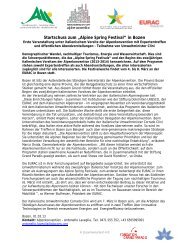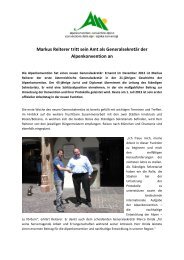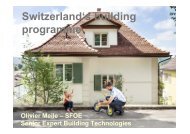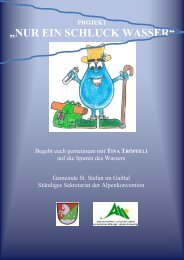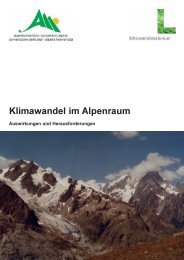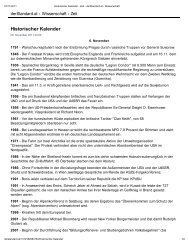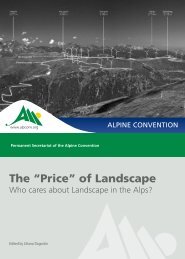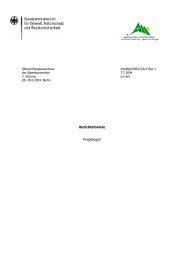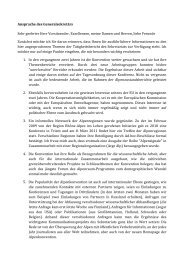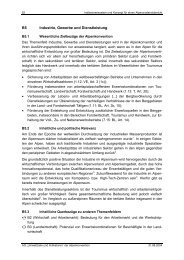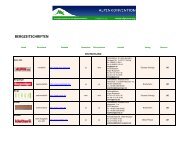ALPINE CONVENTION - Convenzione delle Alpi
ALPINE CONVENTION - Convenzione delle Alpi
ALPINE CONVENTION - Convenzione delle Alpi
Create successful ePaper yourself
Turn your PDF publications into a flip-book with our unique Google optimized e-Paper software.
44<br />
Country Area in km 2 Percent of<br />
Convention<br />
Territory<br />
Administrative units in the territory of the<br />
<strong>Alpi</strong>ne Convention<br />
nUTS 2<br />
(regions,<br />
Länder)<br />
LAU 1<br />
(provinces, cantons,<br />
districts,<br />
counties)<br />
LAU 2<br />
(municipalities)<br />
Austria 54,759 28.7 8 29 1,147<br />
France 40,801 21.4 2 9 1,749<br />
Germany 11,160 5.8 2 13 285<br />
Italy 51,995 27.2 7 24 1,756<br />
Liechtenstein 160 0.1 1 1 11<br />
Monaco 2 < 0.01 1 1 1<br />
Slovenia 6,871 3.6 1 7 62<br />
Switzerland 25,211 13.2 5 15 856<br />
Alps total 190,959 100.0 27 99 5,867<br />
Tab. 1: Shares of area and administrative units in the signatory states (as of 2008).<br />
Map 3: Population distribution – Population density in the <strong>Alpi</strong>ne municipalities<br />
In the municipalities of the <strong>Alpi</strong>ne Convention there<br />
is an average of 147 inhabitants per km 2 . The figures<br />
range from 0.1 inhabitants/km 2 in the smallest<br />
municipality of Rochefourchat in the Rhône Alpes<br />
region to 16,010 inhabitants/km 2 in the most<br />
densely populated municipality of Monaco.<br />
The <strong>Alpi</strong>ne population concentrates in the areas<br />
with ample infrastructure provision, which are the<br />
large inneralpine valleys (Aosta, Rhône, Etschtal/<br />
Val d’Adige, the valley of the river Inn, the Rhine<br />
Valley, the Valtelline) and basin areas (Klagenfurt<br />
Basin) as well the margins of the Alps. In these<br />
areas geomorphologic conditions allow for a larger<br />
percentage of the land to be used for housing<br />
and economic purposes. Moreover, higher population<br />
densities are to be found in the tourist<br />
centres.<br />
Population density in the municipalities, however,<br />
does not reflect the real conditions existent in the<br />
<strong>Alpi</strong>ne signals 1<br />
<strong>Alpi</strong>ne Arch. Due to the steepness and height of<br />
the terrain only a small portion of the whole of the<br />
Alps’ area is suitable for permanent settlement. In<br />
a typical <strong>Alpi</strong>ne region such as South Tyrol only<br />
as little as eight percent of the area can be populated<br />
permanently. In Vorarlberg, Austria, the figure<br />
reaches 24 percent. If one related the number<br />
of inhabitants to the area that can be populated,<br />
the result would be much higher density figures<br />
for most of the municipalities.<br />
It is on this permanent settlement area that use<br />
claims concentrate, asserted by players from<br />
housing development and economy through to<br />
transport and tourism. Conflicts are the logical<br />
consequence. It is exactly in these areas that they<br />
emerge with high intensity, and require an especially<br />
consequent and sustainable development<br />
strategy.





